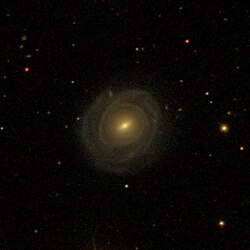| NGC 4326 | |
|---|---|
 SDSS image of NGC 4326. SDSS image of NGC 4326. | |
| Observation data (J2000 epoch) | |
| Constellation | Virgo |
| Right ascension | 12 23 11.6 |
| Declination | 06° 04′ 20″ |
| Redshift | 0.023756 |
| Heliocentric radial velocity | 7122 km/s |
| Distance | 330 Mly (102 Mpc) |
| Apparent magnitude (V) | 14.19 |
| Characteristics | |
| Type | SAB(r)ab+ |
| Size | ~200,700 ly (61.54 kpc) (estimated) |
| Apparent size (V) | 1.5 x 1.1 |
| Other designations | |
| UGC 07454, VCC 0623, PGC 040192, MCG +01-32-033, CGCG 042-064 | |
NGC 4326 is a barred spiral galaxy with a ring located about 330 million light-years away in the constellation Virgo. It was discovered by astronomer William Herschel on April 13, 1784, who described it as "vF, S, R, bM, 1st of 3". It is a large galaxy, with a diameter of around 200,000 ly (61 kpc) making it nearly twice the size of the Milky Way. NGC 4326 is also classified as a LINER galaxy. Despite being listed in the Virgo Cluster catalog as VCC 623, it is not a member of the Virgo Cluster but instead a background galaxy.
NGC 4326 is host to a supermassive black hole with and estimated mass of 3.7×10 solar masses.
Nearby Galaxies
NGC 4326 forms a pair with the galaxy NGC 4333, known as nest 102514, in which NGC 4326 is the birghtest member of the pair. Both galaxies are part of the CfA2 Great Wall.
See also
External links
- NGC 4326 on WikiSky: DSS2, SDSS, GALEX, IRAS, Hydrogen α, X-Ray, Astrophoto, Sky Map, Articles and images
References
- ^ "NASA/IPAC Extragalactic Database". Results for NGC 4326. Retrieved 2022-02-21.
- "HyperLeda -object description". leda.univ-lyon1.fr. Retrieved 2022-02-22.
- ^ "Your NED Search Results". ned.ipac.caltech.edu. Retrieved 2022-02-22.
- "New General Catalog Objects: NGC 4300 - 4349". cseligman.com. Retrieved 2022-02-19.
- "NGC/IC Project Restoration Efforts". ngcicproject.observers.org. Retrieved 2022-02-22.
- "NGC 4326". simbad.u-strasbg.fr. Retrieved 2022-02-22.
- Binggeli, B.; Sandage, A.; Tammann, G. A. (September 1985). "Studies of the Virgo Cluster. II - A catalog of 2096 galaxies in the Virgo Cluster area. V - Luminosity functions of Virgo Cluster galaxies". The Astronomical Journal. 90: 1681. Bibcode:1985AJ.....90.1681B. doi:10.1086/113874.
- Arzoumanian, Zaven; Baker, Paul T.; Brazier, Adam; Brook, Paul R.; Burke-Spolaor, Sarah; Becsy, Bence; Charisi, Maria; Chatterjee, Shami; Cordes, James M.; Cornish, Neil J.; Crawford, Fronefield; Cromartie, H. Thankful; Decesar, Megan E.; Demorest, Paul B.; Dolch, Timothy (2021-06-01). "The NANOGrav 11 yr Data Set: Limits on Supermassive Black Hole Binaries in Galaxies within 500 Mpc". The Astrophysical Journal. 914 (2): 121. arXiv:2101.02716. Bibcode:2021ApJ...914..121A. doi:10.3847/1538-4357/abfcd3. ISSN 0004-637X.
- "[T2015] nest 10214". simbad.u-strasbg.fr. Retrieved 2022-02-22.
- ^ Tully, R. Brent (2015-05-01). "Galaxy Groups: A 2MASS Catalog". The Astronomical Journal. 149 (5): 171. arXiv:1503.03134. Bibcode:2015AJ....149..171T. doi:10.1088/0004-6256/149/5/171. ISSN 0004-6256. S2CID 119285986.
- Hoffman, G. Lyle; Lewis, B. M.; Salpeter, E. E. (1995-03-01). "The Large-Scale Distribution of Late-Type Galaxies between Virgo and the Great Wall". The Astrophysical Journal. 441: 28. Bibcode:1995ApJ...441...28H. doi:10.1086/175333. ISSN 0004-637X.